#Auguste de Marmont
Text

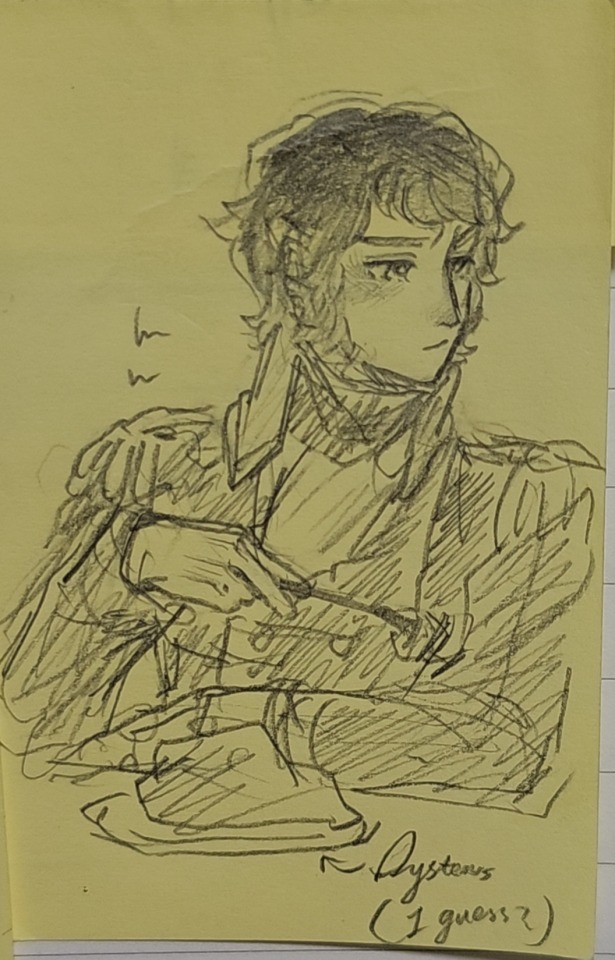








junot's doodles again+ 1 marjuno ^^
71 notes
·
View notes
Text
I need to stop thinking about jurmont before I start feeling bad for marmont, marmont SUCKS, BOOOO JUNOT PICKED NAPOLEON OVER YOU BOOOO
#i only feel a little bit bad#auguste de marmont#jean andoche junot#napoleon bonaparte#napjuno#jurmont#saddie stop planting these ideas in my head you are EVIL#napoleonic#napoleonic era
6 notes
·
View notes
Text

The Four of Toulon✨
#歴史創作#doodle#napoleonic#French Revolutionary Wars#Napoleon Bonaparte#Jean-Andoche Junot#Auguste de Marmont#Géraud Christophe Michel Duroc#Siege of Toulon
29 notes
·
View notes
Text
Happy birthday Marshal Marmont!
July 20, 1774

#marshal marmont#happy birthday#auguste frederic louis viesse de marmont#napoleonic marshals#portrait by andrea appiani
33 notes
·
View notes
Text
Eugène on the capture of Malta
Somebody committed the grave error to show interest in Eugène’s memoirs … so I thought maybe there is some more interest somewhere out there. Most of what Eugène writes is very brief, it’s possible that this was only a first draft, outlining the events, to be elaborated on later. Which never happened, due to Eugène’s death.
I’ll start with the departure of the French army for Egypt. For context: Eugène (16), had just returned from another journey that had taken him on Napoleon’s orders to Corfou, Naples and Rome (where Napoleon’s brother Joseph held the post of French ambassador and where he had witnessed anti-French riots and the death of a general who should have married Napoleon’s ex Desirée Clary).
I accompanied the ambassador [Joseph Bonaparte] to Paris, where I stayed for some time; since, in the first days of April, I received the order to leave, with several of my comrades, for Toulon. General Bonaparte arrived there on 9 May; eight days later, we were embarked on board the one hundred and twenty-gun ship Orient, and on 20 May, all the ships of the fleet set sail. It was a magnificent sight to see more than four hundred sails, protected by thirty ships of the line or frigates, sailing away from the shores of France to chase the glory and hazards of a distant expedition, the aim of which was still unknown to most of us.
At the end of twenty days, we arrived at the sight of Malta, and, the next day, after some talks with the city of Valletta, we disembarked at two different points, to the east and west of this place, at the same time as another column was also making a landing on the island of Gozo.
I was sent, on the morning of 11 June, to General Desaix, and, in the evening, to the chief of brigade Marmont. I was with the latter at the moment when the garrison made a fairly large sortie; it was repulsed with some casualties; five flags were taken from the enemy, and I had the good fortune to capture one. After the affair, I was charged by the chief of brigade Marmont to carry the five flags to General Bonaparte, who was on board the Orient. The following day negotiations with the place were started, and we entered it on the 13th.
The general-in-chief visited the fortifications, and I remember very well hearing General Dufalgua, commander of the army's engineers, jokingly complimenting him on the fact that someone had been found in the fortress to open the doors.
And I can just see one 16-year-old sous-lieutenant being all shocked by this. Treason? When he had just been so proud of the French army gloriously defeating the enemy?
Also interesting to note: There was a time when Marmont and Eugène got along just fine.
25 notes
·
View notes
Text
Happy Birthday, Marshal Marmont!
Considering the length of this post, I guess I’m making up somewhat for all the other Marshals whose birthday I neglected in the past few months. I’m also interested in this Marshal because he has become such a cardboard cutout in the popular imagination, and nobody on Earth is a cardboard cutout; this characterization only makes me more curious about what he was actually like.
A biography of Marmont, in French, was published just a year or two ago. Reading its first pages from the Amazon site ( https://www.amazon.ca/MARMONT-Franck-Favier/dp/2262068054/ref=sr_1_2?crid=2XGX0RQWO1G9P&keywords=marmont&qid=1658303682&s=books&sprefix=marmont%2Cstripbooks%2C127&sr=1-2&asin=B07DGNKW98&revisionId=&format=2&depth=1 ), I found out how carefully educated he was, the one surviving child of well-to-do, happily married, doting parents.
As I’m always interested in links between prominent people of the period, I was happy to discover that he knew an already turbulent Junot from adolescence; that he met Napoleon as early as 1791, and Duroc in 1792; and that in 1793, he was serving under Kellermann, the oldest future Marshal and he, Marmont, the youngest. Their difference in age was forty years.
About Kellermann, Marmont wrote this to his mother: that Kellermann was an old military commander who had previously fought in 16 campaigns, and who took advice from nobody; but who did seek Marmont’s opinion at times, and who adopted it. Did Kellermann do so? I don’t know, but Marmont’s education was excellent, as previously noted, and whatever one might think about him he was one sharp tack.
Finally, this is some of what old curmudgeon McDonnell wrote about Marmont's time in Dalmatia: "His activity was prodigious. He set up a new constitution for the ancient city of Ragusa, conducted negotiations with Turkey and Montenegro, created the Dalmatian Legion, appointed new judges, reorganized the finances of both his army and of the country, established large depôts in various towns in order to enable him to march independently of lines of communication, drew up plans for an invasion of Turkey, decentralized the military hospitals, built fortifications, bridges, dykes, among the marsh-lands and cutting through the rocks, and during his governorship visited every village and hamlet in all Dalmatia, and knew every hill and mountain by its name." I wish I had this kind of energy.
29 notes
·
View notes
Note
I DEMAND YOU CREATE ANOTHER POLL !! And do not call it a “pity poll” unless you want your house flooded with my vikings
-Bernadotte
MARSHALATE PITY BALLOT
VOTE FOR ONE OF THE LESS POPULAR LES GRANDE CHAPEAUX!!! SOMEHOW BERTHIER THE NERD WON THE FIRST POLLE WITH ME IN SECOND PLACE SO LETS DO THIS SHIT AGAIN
IN CASE YOU DONT KNOW WHO WE ARE WE HAVE A "OUIKIPEDIA PAGE" ALL ABOUT US AND OUR BIG HATS BUT LONG STORY SHORT WERE NAPOLEONS TOP COMMANDERS WHO FUCK SHIT UP FOR HIM
SO ONCE AGAIN VOTE FOR WHOEEVER THE FUCK YOU WANT WHETHER THATS THE BEST OR THE SEXIEST OR THE MOST PATHETIC
YOU CAN EVEN STUFF THE BALLOTS IF YOU WANT THE EMPEROR DID IT SO WHY NOT YOU
This is a public service announcement. Do not engage in vote manipulation. -Maréchal Soult
IVE DEFINITELY NOT FORGOTTEN ANYONE THIS TIME AND THERES NOBODY SNEAKING ONTO THE BALLOT!!!!
FEEL FREE TO POST PROPAGANDA OR ANTI PROPAGANDA WE WILL SHARE IT IF ITS FUNNY
ALSO DO SHARE THIS SO THAT WE CAN SEE WHO WINS THE PITY VOTE AND MAYBE PIT THEM AGAINST BERTHIER IN A CAGE FIGHT
WHERES GROUCHY
#exchanges with that guy who is now swedish#dispatches from the marshal#napoleon's marshals#marshalate popularity poll#marshalate popularity ballot
60 notes
·
View notes
Text
Tag Yourself: Unabridged Shitty Drawing Marshal of the Empire Edition
Yes All 26 Of Them + Bonus 2
drawn and compiled by yours truly, initial and probably inaccurate research assisted by Chet Jean-Paul Tee, additional research from Napoleon and his Marshals by A G MacDonnell, Swords Around A Throne by John R Elting and a bunch of other books and Wikipedia pages
captions under images
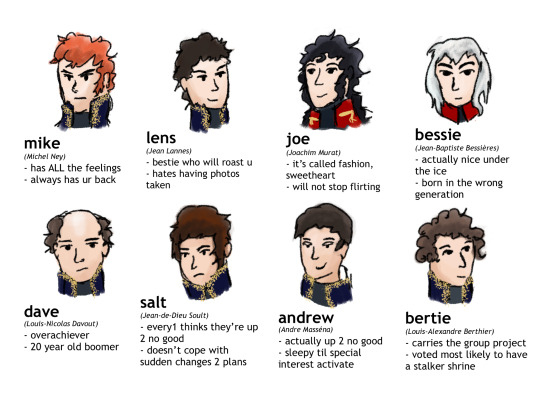


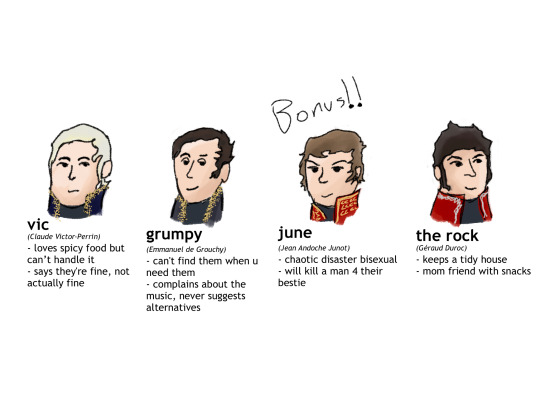
mike (Michel Ney)
- full of every emotion
- always has ur back
joe (Joachim Murat)
- it's called fashion sweetheart
- will not stop flirting
lens (Jean Lannes)
- bestie who will call u out on ur shit
- does not like their photo taken
bessie (Jean-Baptiste Bessieres)
- actually nice under the ice
- was born in the wrong generation
dave (Louis-Nicolas Davout)
- overachiever
- 20 year old boomer
salt (Jean-de-Dieu Soult)
- people think ur up to no good
- doesn’t cope with sudden changes 2 plans
andrew (Andre Massena)
- actually up to no good
- sleepy until special interest is activated
bertie (Louis-Alexandre Berthier)
- carries the group project
- voted most likely to make a stalker shrine
auggie (Pierre Augereau)
- shady past full of batshit stories
- will not stop swearing in the christian minecraft server
lefrank (François Joseph Lefebvre)
- dad friend
- in my day we walked to school uphill both ways
big mac (Étienne Macdonald)
- brutally honest
- won't let you borrow their charger even if they have 100%
gill (Guillaume Brune)
- love-hate relationship with group chats
- pretends not to care, checks social media every 2 minutes
ouchie (Nicholas Oudinot)
- needs to buy bandages in bulk
- a little aggro
pony (Józef Antoni Poniatowski)
- can't swim
- tries 2 hard to fit in, everyone secretly loves them anyway
grumpy (Emmanuel de Grouchy)
- can't find them when u need them
- complains about the music, never suggests alternatives
bernie (Jean-Baptiste Bernadotte)
- always talks about their other friendship group
- most successful, nobody knows how
monty (Auguste de Marmont)
- does not save u a seat
- causes drama and then lurks in the background
monch (Bon-Adrien Jeannot de Moncey)
- last to leave the party
- dependable
morty (Édouard Mortier)
- everyone looks up 2 them literally and figuratively
- golden retriever friend
jordan (Jean-Baptiste Jourdan)
- volunteers other people for things
- has 20+ alarms but still oversleeps
kelly (François Christophe de Kellermann)
- old as balls but still got it
- waiting in the wings
gov (Laurent de Gouvion Saint-Cyr)
- infuriatingly modest about their art skills
- thinks too much before they speak
perry (Catherine-Dominique de Pérignon)
- low-key rich, only buys things on sale
- “let’s order pizza” solution to everything
sachet (Louis-Gabriel Suchet)
- dependable friend who always brings snacks
- lowkey keeps the group together
cereal (Jean-Mathieu-Philibert Sérurier)
- unnervingly methodical and precise about fun
- will delete your social media after u die
vic (Claude Victor-Perrin)
- loves spicy food but can’t handle it
- says they're fine, not actually fine
Bonus!
june (Jean Andoche Junot)
- chaotic disaster bisexual
- will kill a man 4 their bestie
the rock (Géraud Duroc)
- keeps a tidy house
- mom friend with snacks
#napoleon’s marshals#napoleonic era#napoleonic shitposting#napoleonic wars#history shitposting#cadmus draws#I thought it would be funny if it was hand drawn#i had to draw these over a few weeks or else my RSI ridden fingers would explode#I will reblog this a few times because this is so stupid and I’m proud of this#yes chatgpt helped because I’m not actually familiar with most of the 26#ended up editing a lot of it but some entries are less based on history and more based on vibes#and as we know vibes are extremely accurate
133 notes
·
View notes
Text
Friends, enemies, comrades, Jacobins, Monarchist, Bonapartists, gather round. We have an important announcement:
The continent is beset with war. A tenacious general from Corsica has ignited conflict from Madrid to Moscow and made ancient dynasties tremble. Depending on your particular political leanings, this is either the triumph of a great man out of the chaos of The Terror, a betrayal of the values of the French Revolution, or the rule of the greatest upstart tyrant since Caesar.
But, our grand tournament is here to ask the most important question: Now that the flower of European nobility is arrayed on the battlefield in the sexiest uniforms that European history has yet produced (or indeed, may ever produce), who is the most fuckable?
The bracket is here: full bracket and just quadrant I
Want to nominate someone from the Western Hemisphere who was involved in the ever so sexy dismantling of the Spanish empire? (or the Portuguese or French American colonies as well) You can do it here
The People have created this list of nominees:
France:
Jean Lannes
Josephine de Beauharnais
Thérésa Tallien
Jean-Andoche Junot
Joseph Fouché
Charles Maurice de Talleyrand
Joachim Murat
Michel Ney
Jean-Baptiste Bernadotte (Charles XIV of Sweden)
Louis-Francois Lejeune
Pierre Jacques Étienne Cambrinne
Napoleon I
Marshal Louis-Gabriel Suchet
Jacques de Trobriand
Jean de dieu soult.
François-Étienne-Christophe Kellermann
17.Louis Davout
Pauline Bonaparte, Duchess of Guastalla
Eugène de Beauharnais
Jean-Baptiste Bessières
Antoine-Jean Gros
Jérôme Bonaparte
Andrea Masséna
Antoine Charles Louis de Lasalle
Germaine de Staël
Thomas-Alexandre Dumas
René de Traviere (The Purple Mask)
Claude Victor Perrin
Laurent de Gouvion Saint-Cyr
François Joseph Lefebvre
Major Andre Cotard (Hornblower Series)
Edouard Mortier
Hippolyte Charles
Nicolas Charles Oudinot
Emmanuel de Grouchy
Pierre-Charles Villeneuve
Géraud Duroc
Georges Pontmercy (Les Mis)
Auguste Frédéric Louis Viesse de Marmont
Juliette Récamier
Bon-Adrien Jeannot de Moncey
Louis-Alexandre Berthier
Étienne Jacques-Joseph-Alexandre Macdonald
Jean-Mathieu-Philibert Sérurier
Catherine Dominique de Pérignon
Guillaume Marie-Anne Brune
Jean-Baptiste Jourdan
Charles-Pierre Augereau
Auguste François-Marie de Colbert-Chabanais
England:
Richard Sharpe (The Sharpe Series)
Tom Pullings (Master and Commander)
Arthur Wellesley, 1st Duke of Wellington
Jonathan Strange (Jonathan Strange & Mr. Norrell)
Captain Jack Aubrey (Aubrey/Maturin books)
Horatio Hornblower (the Hornblower Books)
William Laurence (The Temeraire Series)
Henry Paget, 1st Marquess of Anglesey
Beau Brummell
Emma, Lady Hamilton
Benjamin Bathurst
Horatio Nelson
Admiral Edward Pellew
Sir Philip Bowes Vere Broke
Sidney Smith
Percy Smythe, 6th Viscount Strangford
George IV
Capt. Anthony Trumbull (The Pride and the Passion)
Barbara Childe (An Infamous Army)
Doctor Maturin (Aubrey/Maturin books)
William Pitt the Younger
Robert Stewart, 2nd Marquess of Londonderry (Lord Castlereagh)
George Canning
Scotland:
Thomas Cochrane
Colquhoun Grant
Ireland:
Arthur O'Connor
Thomas Russell
Robert Emmet
Austria:
Klemens von Metternich
Friedrich Bianchi, Duke of Casalanza
Franz I/II
Archduke Karl
Marie Louise
Franz Grillparzer
Wilhelmine von Biron
Poland:
Wincenty Krasiński
Józef Antoni Poniatowski
Józef Zajączek
Maria Walewska
Władysław Franciszek Jabłonowski
Adam Jerzy Czartoryski
Antoni Amilkar Kosiński
Zofia Czartoryska-Zamoyska
Stanislaw Kurcyusz
Russia:
Alexander I Pavlovich
Alexander Andreevich Durov
Prince Andrei (War and Peace)
Pyotr Bagration
Mikhail Miloradovich
Levin August von Bennigsen
Pavel Stroganov
Empress Elizabeth Alexeievna
Karl Wilhelm von Toll
Dmitri Kuruta
Alexander Alexeevich Tuchkov
Barclay de Tolly
Fyodor Grigorevich Gogel
Ekaterina Pavlovna Bagration
Ippolit Kuragin (War and Peace)
Prussia:
Louise von Mecklenburg-Strelitz
Gebard von Blücher
Carl von Clausewitz
Frederick William III
Gerhard von Scharnhorst
Louis Ferdinand of Prussia
Friederike of Mecklenburg-Strelitz
Alexander von Humboldt
Dorothea von Biron
The Netherlands:
Ida St Elme
Wiliam, Prince of Orange
The Papal States:
Pius VII
Portugal:
João Severiano Maciel da Costa
Spain:
Juan Martín Díez
José de Palafox
Inês Bilbatua (Goya's Ghosts)
Haiti:
Alexandre Pétion
Sardinia:
Vittorio Emanuele I
Lombardy:
Alessandro Manzoni
Denmark:
Frederik VI
Sweden:
Gustav IV Adolph
45 notes
·
View notes
Text
Napoleon's Marshals and their Birthstones Part 2
This is part 2 of my series where I list all 26 marshal's birthstones, I'll also be adding two non-marshals to the list ;). In this post I'll go over months May through August, the format will be the same as the last post. If you want to review the terms used in the post I'll put the link to the first part here .
--------------------------------------------------------------
Emerald (May)
Marshals- Davout, Kellermann, Massena, Perignon, and Poniatowski
Type: Mineral
Group: Beryl (Be₃Al₂(SiO₃)₆)
Color: Green or bluish-green
Cleavage: Indistinct to none
Fracture: Conchoidal
Mohs Scale: 7.5-8
Luster: Vitreous
Streak: White
Fun Fact: Emerald is one of the four cardinal (most valuable) gemstones, along with diamond, ruby, and sapphire. Its value is due to the limited amount of beryllium (an element in beryl minerals) found in one location on the surface of the Earth, making it rare to find. An even rarer type of emerald is a trapiche emerald, which has the shape of a wheel, with each piece of emerald separated by the inclusion of black shale; the shale becomes less present as time passes. Its green color is due to the presence of chromium or vanadium in its chemical composition. Traces of iron make the color turn into a bluish or yellowish tint.
Pearl (June)
Marshals- N/A (Honorable mention: Joséphine de Beauharnais)
Type: Mineral
Group: Carbonate (CaCo₃)
Color: White, pink, silver, cream, iridescent, blue, gold
Cleavage: None
Fracture: Uneven
Mohs Scale: 2.5-4.5
Luster: Pearly
Streak: White
Fun Facts: Pearls are made either naturally or synthetically. Natural pearls are formed inside the soft tissue of various mollusk species like oysters and mussels when an irritant such as sand gets inside the mollusk. As a defense mechanism, the mollusk covers the object with a substance called nacre, a combination of aragonite and conchiolin. These layers build up over time until they create a pearl. Man-made or cultured pearls are formed when a small piece of a mussel shell is inserted into the mollusk's tissue, causing the mollusk to secrete nacre onto the shell piece. Under a controlled environment, pearls form a perfectly shaped sphere, rather than forming in irregular shapes like organic pearls form.
Ruby (July)
Marshals- Moncey, and Marmont
Type: Mineral
Group: Oxide (Al₂O₃)
Color: Blood red, orange red, pink, or purple red
Cleavage: Indistinct
Fracture: Conchoidal or splintery
Mohs Scale: 9
Luster: Vitreous
Streak: White
Fun Fact: Rubies have the same chemical composition as sapphires, making them the same type of mineral (corundum), the only difference being that rubies are red due to chromium in their crystal lattice, while sapphires are blue, but it does come in different colors [1]. Rubies are not only known for their use in expensive jewelry but also for having major cultural significance ranging from ancient to modern times. In ancient Greece, rubies were thought to preserve mental and physical strength. Many Greek warriors wore talismans with rubies as protection when heading into battles [2].
Peridot (August)
Marshals- Bessières (Honorable mention: Napoleon Bonaparte)
Type: Mineral
Group: Silicate ((Mg,Fe)₂SiO₄)
Color: Green, yellowish-green, olive-green
Cleavage: Poor
Fracture: Conchoidal
Mohs Scale: 6.5-7
Luster: Vitreous or greasy
Streak: Colorless
Fun Fact: Peridot can be dissolved in hydrochloric acid, creating a gelatinous silica form. It was first discovered on the volcanic island of Zabargad in the Red Sea (located near Egypt) 3,500 years ago. The largest known peridot was also discovered in Egypt, weighing approximately 319 carats. The Egyptians were very fond of peridot and believed it to be the gemstone of the sun god Ra, giving it the name the 'evening emerald.' When determining the value of a peridot, its color plays an important role. Peridots with a pure green hue are more desirable than those with a yellowish tint (high iron levels are present). Peridot is also the gemstone with the most inclusions visibly present, which can affect its value, but it is often attributed to it being part of its natural structure.
--------------------------------------------------------------
Sources:
Emerald: King, H. M. (n.d.). Emerald. geology. https://geology.com/gemstones/emerald/
Pearl: MAT, M. (2023, August 26). Pearl: Mineral, gemstone: Properties, formation, occurrence. Geology Science. https://geologyscience.com/minerals/organic-minerals/pearl/?amp
Ruby: [1] King, H. M. (n.d.). Ruby and Sapphire. geology. https://geology.com/gemstones/ruby-and-sapphire/
[2] MAT, M. (2023, April 25). Ruby: Properties, formation, occurrence " Geology science. Geology Science. https://geologyscience.com/gemstone/ruby/?amp
Peridot: MAT, M. (2023, August 29). Peridot : Gemstone, properties, occurrence and uses " geology science. Geology Science. https://geologyscience.com/gemstone/peridot/?amp
#napoleonic era#napoleon bonaparte#french history#napoleon's marshals#rocks and minerals#gemstone#birthstone#napoleonic wars#funny how none of the marshals was born in June#pearl is quit fitting for Josephine xD#peridot too since bessi is known for wearing his green uniform#also pearls are technically not a mineral due to it being organically created#what is considered a mineral is the aragonite in its structure
15 notes
·
View notes
Text
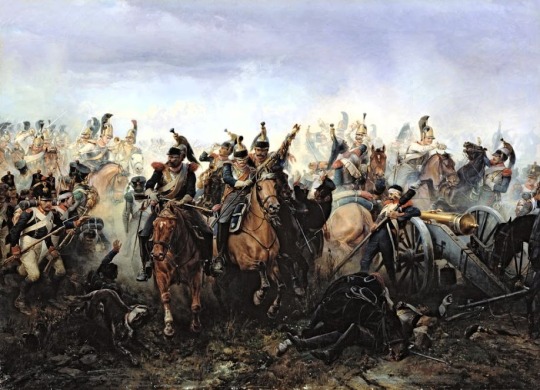
The Battle of Fère-Champenoise (25 March 1814) was fought between two Imperial French corps led by Marshals Auguste de Marmont and Édouard Mortier, duc de Trévise and a larger Coalition force composed of cavalry from the Austrian Empire, Kingdom of Prussia, Kingdom of Württemberg, and Russian Empire…
Please follow link for full post
Zaidan,Paintings,Arthistory,Biography,War,History,fineart,Artists,footnotes,Bogdan Pavlovich Willewalde,
01 Work, The Art of War, Bogdan Willewalde's the battle of Fère-Champenoise, with footnotes
0 notes
Text

Philippines - METRO SOCIETY, August 2023
#Fashion: On Saturday, new #Gucci creative director Sabato De Sarno (@sabatods) offered a glimpse of his vision for the stalled Italian megabrand, posting an image from a high jewellery campaign starring model Daria Werbowy (@dotwillow) to his personal Instagram account.
The visual, shot by photographer David Sims (@davidsimsofficial) and styled by Alastair McKimm (@alastairmckimm), features Werbowy curled up next to the pool at Los Angeles’ Chateau Marmont hotel wearing oversized, gold statement earrings and subtly branded black bikini briefs.
Little had been heard from De Sarno since he was named successor to former Gucci designer Alessandro Michele in January. And with only weeks to go until his catwalk debut in Milan next month, some industry insiders were left scratching their heads.
The ad’s stripped-back aesthetic, along with the casting of Werbowy, who appeared in a 2004 campaign for Tom Ford’s Gucci and became the face of Phoebe Philo’s Céline before retiring in 2016, is in keeping with Gucci’s attempts to reinforce its high-end credentials as it works to transition from what parent company Kering has described as an era of fashion-driven “reinvention” to a new chapter of “sustainable elevation.” #linkinbio
(✍️ @tamisonoconnor
📷 @sabatods/ @bof)
.
.
.
#LuxuryFashion #gucci #sabatodesarno @andeedgque
0 notes
Photo
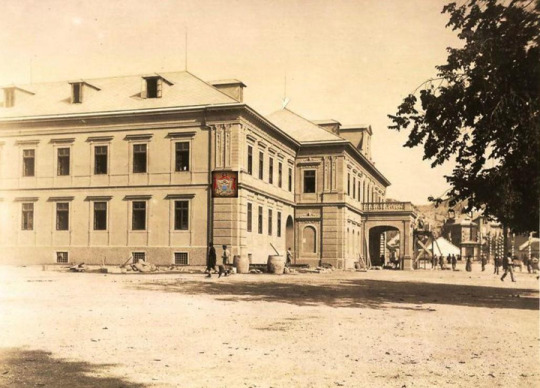
Crna Gora na granici Francuskog carstva
U vrijme Napoleona Crna Gora se nekoliko godina graničila sa Francuskim Carstvom - Ilirskim Provincijama (1809 – 1813)* a nakon odlaska Francuza godinu dana držala pod okupacijom Boku Kotorsku ( 1813-1814). Taj period ostavo je tragove na tadašnje crnogorsko društvo prije svega preko modernog francuskog gradjanskog zakonika (Code civil)**. Uvodjenjem gradjanskog zakona u Ilirske provincije pa tako i region Boke Kotoske gdje je do tada bila astrougarska vojna upava, bila je velka promjena koja je omogućila Crnogorcima da se slobodnije kreću po primorju i razvijaju svoje aktivnosti, dolaze u kontakt sa iskustvima, novim idejama koja su ostavili Francuzi.
Poznato je takodje da su i ranije crnogorski vladari i drugi učeni ljudi bili impresionrani Francuskom istorijom i civilizacijom pa i kuhinjom kao dijelom te civilizacije. Već na prvi pogled na biblioteku Petra I i Petra II u Cetinjskoj Biljardi daju se uočiti dijela Voltera i velika zbika iz gradjanske i krivičnopravne literature.
Da bi pokazali da u Cranoj Gori interes za francusku kulturu i jezik ne počinje sa turizmom već mnogo ranije, često smo za vrijeme prve posjete Crnoj Gori mogli čuti anegdotu o susretu Petra I Petrovića sa Maršalom Marmont, “negdje iznad Braića”. Kada se postavilo pitanje na kome jeziku da se vode razgovori, Petar I je predložio da to bude Francuski.
Veze sa Francuskom su ojačale za vrijeme Knjaza Danila koji je putovao u Francusku i susrio se sa Napoleonom III dobivši od njega podršku u novcu ali ne i formalno priznanje Crne Gore čemu se Danilo nadao.
Napolon III kum crnogorske državnosti
Podrška Napoleona III na Pariskom kongresu 1856, blokiranje pretenzije Turske na Crnu Goru, predstavljali su značajan korak ka uključenju Kneževine Crne Gore u medjnarodnu zajednicu na Berlinskom Kongresu 1878 godine. Tako je Napolon III kumovao Crnogorskoj državnosti.
Veliki pobornik Francuske kulture bila je princesa Darinka, Danilova supruga iz tršćanske porodice Kustić koja je ne samo donijela francuski uticaj već ga takodje prenosila na svoju okolinu na dvoru. Po njenoj sugestiji prestolonasljednik Nikola - budući Knjaz i Kralj Nikola I, poslan je na školovanje u Paris gdje je posjećivao renomirani Lycee Louis le Grand.
Kada je Crna Gora na Berlinskom kongresu konačno ušla u duštvo modernih evropskh država iskustva i znanja koja je Nikola kao mladi princ stekao u Parisu bila su dragocijena za njega kao vladara u vodjenju diplomatije i učvršćenju prestiža Crnogorskog dvora širom Evrope. Tokom čitavog perioda svoje vladavine Nikola je modernizaciju crnoorskog društva, političkog, ekonomskog i kulturnog života usmjeravao uglavnom na “francuski način”.
Ali i Frncuzi su bili pasionirani Crnom Gorom. Uvodjenju Crne Gore “a la mode” u Francusko društvo kao i dugih evropskih država, doprinijeli su svojim putopisima i literarnim djelima ugledne ličnosti koje su tokom XIX vijeka posjećivale Crnu Goru, Contre-Amiral Jean-Pierre Edmond Jurien de La Gravière, mornaricki oficir i romnsijer Pierre Loti, Général Comte de Beaumont, Baron de Leaumont, Commandant de Cavalerie Baron de Saint-Lambert, Paul Loubet - sin predsjednika republike Émile Loubet kome je bio i sekretar. Crna Gora bila je destinacija poznatih naučnika toga vremena Ami Bue, Jacques Louis Vialla, Xavier Marmier, Georges Leroy, inžinjer Alphonse Muzet.
Podsjetimo i na istorijskie ličnosti - predsjednik Raymond Poincaré i Maréchal Duc de Raguse Louis de Marmont koji je kako smo vidijeli u memoriji je svih turističkih vodiča.
Današnji posjetioci tadašnju crnogorsku kraljevsku prestolnicu Cetine, u prilici su da osjete duh toga vremena kroz gradjevine i spomenke koji svjedoče o crnogorsko francuskom prijateljstvu – kada je Crnogorska država pripadala modernoj Evropi kojoj danas 100 godina kasnije pokušava da se ponovo vrati. Mauzolej na Orlovom Kršu djelo je skluptora Paul Moreau-Vauthier, Zgrada Francuske ambasade sagradjena 1910, djelo je arhitekata Paul Gaudet i August Perret. Za ovu gradjevinu orijentalne ljepote, postoji priča da je bila namijenjena da bude u Kairo ali da su greškom planovi zamijenjeni. Prvu modernu bolnicu “Danilo I” koja je još u upotrebi sagradio je 1873 dvorski ljekar Dr. Gabriel Frilley.
0 notes
Text

Marmont🏵
12 notes
·
View notes
Text
The Battle of Ulm on 16th – 19th October, 1805 was a series of skirmishes, at the end of the Ulm Campaign, which allowed Napoleon I to trap an entire Austrian army under the command of Karl Freiherr Mack von Leiberich with minimal losses and to force its surrender near Ulm in the Electorate of Bavaria.
In 1805, the United Kingdom, the Austrian Empire, Sweden, and the Russian Empire formed the Third Coalition to overthrow the French Empire. When Bavaria sided with Napoleon, the Austrians, 72,000 strong under Mack, prematurely invaded while the Russians were still marching through Poland.
Napoleon had 177,000 troops of the Grande Armée at Boulogne, ready to invade England.
They marched south on 27th August and by 24th September were ready to cross the Rhine from Mannheim to Strasbourg. After crossing the Rhine, the greater part of the French army made a gigantic right wheel so that its corps reached the Danube simultaneously, facing south.
On 7th October, Mack learned that Napoleon planned to cross the Danube and march around his right flank so as to cut him off from the Russians who were marching via Vienna. He accordingly changed front, placing his left at Ulm and his right at Rain, but the French went on and crossed the Danube at Neuburg, Donauwörth, and Ingolstadt.
Unable to stop the French avalanche, Michael von Kienmayer's Austrian corps abandoned its positions along the river and fled to Munich.
On 8th October, Franz Auffenberg's division was cut to pieces by Joachim Murat's Cavalry Corps and Jean Lannes' V Corps at the Battle of Wertingen.
The following day, Mack attempted to cross the Danube and move north. He was defeated in the Battle of Günzburg by Jean-Pierre Firmin Malher's division of Michel Ney's VI Corps which was still operating on the north bank.
During the action, the French seized a bridgehead on the south bank. After first withdrawing to Ulm, Mack tried to break out to the north. His army was blocked by Pierre Dupont de l'Etang's VI Corps division and some cavalry in the Battle of Haslach-Jungingen on 11th October.
By the 11th, Napoleon's corps were spread out in a wide net to snare Mack's army. Nicolas Soult's IV Corps reached Landsberg am Lech and turned east to cut off Mack from Tyrol.
Jean-Baptiste Bernadotte's I Corps and Louis Nicolas Davout's III Corps converged on Munich. Auguste Marmont's II Corps was at Augsburg. Murat, Ney, Lannes, and the Imperial Guard began closing in on Ulm. Mack ordered the corps of Franz von Werneck to march northeast, while Johann Sigismund Riesch covered its right flank at Elchingen. The Austrian commander sent Franz Jellacic's corps south toward Tyrol and held the remainder of his army at Ulm.
On 14th October, Ney crushed Riesch's small corps at the Battle of Elchingen and chased its survivors back into Ulm. Murat detected Werneck's force and raced in pursuit with his cavalry. Over the next few days, Werneck's corps was overwhelmed in a series of actions at Langenau, Herbrechtingen, Nördlingen, and Neresheim. On 18th October, he surrendered the remainder of his troops. Only Archduke Ferdinand Karl Joseph of Austria-Este and a few other generals escaped to Bohemia with about 1,200 cavalry.
Meanwhile, Soult secured the surrender of 4,600 Austrians at Memmingen and swung north to box in Mack from the south. Jellacic slipped past Soult and escaped to the south only to be hunted down and captured in the Capitulation of Dornbirn in mid-November by Pierre Augereau's late-arriving VII Corps. By 16th October, Napoleon had surrounded Mack's entire army at Ulm, and four days later Mack surrendered with 25,000 men, 18 generals, 65 guns, and 40 standards.
Some 20,000 escaped, 10,000 were killed or wounded, and the rest made prisoner.
About 500 French were killed and 1,000 wounded, a low number for such a decisive battle.
In less than 15 days the Grande Armée neutralized 60,000 Austrians and 30 generals. At the surrender (known as the Convention of Ulm), Mack offered his sword and presented himself to Napoleon as "the unfortunate General Mack". Mack was court-martialed and sentenced to two years' imprisonment.
(Information From Wikipedia)

0 notes
Text
Napoleonic birthday calendar
A quick first attempt at a combined calender; I hope I have not accidentally dropped somebody on the way [searches floor]. Whom or what else should we add? I’ve already taken the liberty to add Junot and Duroc.
And just for the record: All the work was done by @northernmariette, I’m just posting on her behalf due to technical problems.
January
3 Jan 1777: Elisa Bonaparte-Baciocchi
7 Jan 1768: Joseph Bonaparte
🎖 10 Jan 1769: Marshal Ney
🎖 26 Jan 1763: Marshal Bernadotte
February
🎖 13 Feb 1768: Marshal Mortier
March
🎖 2 Mar 1770: Marshal Suchet
🎖 13 Mar 1763: Marshal Brune
20 Mar 1822: Napoléon II,
25 Mar 1782: Caroline Bonaparte-Murat
🎖 25 Mar 1767: Marshal Murat
27 Mar 1746: Charles (Carlo) Bonaparte
🎖 29 Mar 1769: Marshal Soult
April
10 Apr 1783: Hortense de Beauharnais-Bonaparte
🎖 10 Apr 1769: Marshal Lannes
🎖 13 Apr 1764: Marshal Gouvion Saint-Cyr
🎖 25 Apr 1767: Marshal Oudinot
🎖 29 Apr 1762: Marshal Jourdan
May
🎖 6 May 1758: Marshal Masséna
🎖 7 May 1763: Marshal Poniatowsky
🎖 10 May 1770: Marshal Davout
21 May 1775: Lucien Bonaparte
🎖 28 May 1735: Marshal Kellerman
🎖 31 May 1754: Marshal Pérignon
June
23 June 1763: Joséphine Bonaparte
July
🎖 20 Jul 1774: Marshal Marmont
🎖 31 Jul 1754: Marshal Moncey
August
🎖 6 Aug 1768: Marshal Bessières
15 Aug 1769: Napoléon Bonaparte
24 Aug 1750: Laetitia Ramolino-Bonaparte
September
2 Sept 1778: Louis Bonaparte
3 Sept 1781: Eugène de Beauharnais
24 Sept 1771: Junot
October
20 Oct 1780: Pauline Bonaparte
🎖 21 Oct 1759: Marshal Augereau
🎖 23 Oct 1766: Marshal Grouchy
🎖 25 Oct 1755: Marshal Lefebvre
25 Oct 1772: Duroc
November
15 Nov 1784: Jérôme Bonaparte
🎖 17 Nov 1765: Marshal Macdonald
🎖 20 Nov 1753: Marshal Berthier
December
🎖 7 Dec 1764: Marshal Victor
🎖 8 Dec 1742: Marshal Serurier
12 Dec 1791: Marie-Louise Bonaparte
31 notes
·
View notes